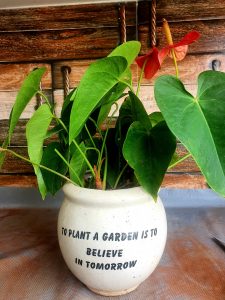Little bit of nostalgia, lots of awe and oodles of...
Read More5 Asanas for A Healthy Heart


Heart, that tiny organ, the size of our two hands clasped together, holds immense power, works so religiously and has an important job in keeping our body running. It plays an important function in pumping blood through the circulatory system to nourish all organs and tissues in the body.
I was operated for mitral valve stenosis. The normal diameter of the mitral annulus is 2.7 to 3.5 cms. At both times, I was operated when the valve size had reduced to less than 1 cm. This caused me breathlessness and tiredness easily and I couldn’t do physical activities at the level of my peers.
That’s how one little defect can have such a huge impact on our entire functioning.
So, if you are looking for an ideal time to start taking care of your heart, it is NOW!
Well, though it has also taught me the most beautiful lesson. Defects, flaws, imperfections are not unnatural. Accepting them, working on them and managing yourself accordingly is what strengthens you as a whole.
AMAZING FACTS ON HEART (source: Cleveland Clinic)
- It beats 100,000 times a day
- Each minute your heart pumps 1.5 gallons of blood.
- Your heart is a coordinated machine. The right side pumps blood into your lungs, while the left side pumps it back into your body.
- A normal heart pumps approximately 4 tablespoons of blood with each beat.
- The heart pumps blood through 60,000 miles of blood vessels!
- Happiness and a strong sense of emotional vitality help lower your risk of heart disease
- The beating sound is the clap of valve leaflets opening and closing.
- Regular exercise is the single most important key to heart health. And it is FREE.
Below, I’m sharing a heart healthy routine that you can include in your morning rituals.
ASANAS FOR GOOD HEART HEALTH
Yoga is a holistic and integral science of life dealing with physical, mental, emotional and spiritual health of the individual. The deeper you go into its studies, you’ll realize that it’s a way of life that provides an opportunity to look inward and forget the madness happening outside.
Yoga includes stretching exercises, asanas, breathing and meditation making it a lifestyle more than just flexibility of the body. There is a certain calm confidence that regular asana practice brings to the mind by which we can understand ourselves and our surroundings better.
These asanas have been recommended by my aunt who is a Yoga practitioner and a certified Yoga teacher for the past 3 decades with Yogashri, Bangalore.
Paschimottanasana –


- Sit up with the legs stretched out straight in front of you, keeping the spine erect and toes flexed toward you.
- Bring your arms straight out to the sides.
- Inhale and draw your spine up long as you raise both arms above your head and stretch up.
- While exhaling, bend forward from the hip joints, chin moving toward the toes. Keep the spine erect focusing on moving forwards towards the toes, rather than down towards the knees.
- Place your hands on your legs, wherever they reach, without forcing. If you can, take hold of your toes and pull on them to help you go forward.
- On each inhale, lengthen your spine. You may come a bit out of your forward bend to do this.
- On each exhale, deepen into your forward bend. Imagine your belly coming to rest on your thighs, rather than your nose coming to your knees. This will help you keep your spine long.
Adho Mukha Shvanasana –


- Stand on four limbs, such that your body forms a table-like structure.
- Exhale and gently lift your hips and straighten your elbows and knees. You need to ensure your body forms an inverted ‘V’.
- Your hands should be in line with your shoulders, and your feet in line with your hips. Make sure that your toes point outwards.
- Now, press your hands into the ground and lengthen your neck. Your ears should touch your inner arms, and you should turn your gaze to your navel.
- Hold for a few seconds, and then, bend your knees and return to the table position.
Gomukhasana –


- Sit erect on the ground with your legs stretched out in front of you
- Now gently bend your left leg, and place it under your right buttock.
- Fold your right leg and place it over your left thigh.
- Place both your knees close together as they are stacked one on top of the other.
- Gently fold your left arm and place it behind your back.
- Take your right arm over your right shoulder, and stretch it as much as you can until it reaches your left hand. With practice, you will be able to not just reach, but also catch your left hand.
- Keep the back erect and expand your chest.
- Hold this pose for as long as you are comfortable, as you breathe slowly and deeply. Concentrate on your breathing.
Parvatasana –


- Sit on the floor with your back straight and with legs stretched in front of you and hands kept freely beside the body.
- Now, sit in the action of Padmasana or the cross legged pose means that your right leg is on the left thigh and the left leg is on the right thigh.
- After this, inhaling slow and deep about 3 seconds and join the palms in namaskar mudra and stretch the hands upward over the head.
- Now pull the body and hands well upwards with keeping your hips on the floor and feel the deep stretch in the body.
- Maintain the final pose for 30-40 seconds.
- With the breathing normally and then release the pose and slowly return to the starting pose.
Shashankasana –


- Sit in Vajrasana resting the palms on the thighs right above the knees. Keep the eyes closed and relax the whole body.
- Inhale and raise the arms above the head. Elbows must be straight, maintain shoulder width apart distance between the arms.
- Exhale and slowly move the torso in the forward direction. Bend from the pelvic region not from the spinal.
- Keep the arms slightly bent and rest the hands, forehead, and elbows on the mat. Arms must be in front of the knees. This is the final position.
- Retain the position as long as comfortable. It could be practice from a minute to 5 minutes.
- To go back in the base position, exhale and slowly lift the forehead, arms to the vertical position, Lower the arms resting the palms on the thighs.
- Relax and take deep breaths.
PRANAYAMA
Nadishuddi Pranayama – Alternate Nostril Breathing Exercise
This is said to balance the main left and right nadis (energy channels), causing prana (life force, energy) to flow through the central energy channel.


- Begin by taking some deep, smooth breaths through the nose.
- With your right hand, close the first two fingers in towards your palm. Your thumb and ring finger should be free to close off the nostrils.
- So for the first round, close you right nostril gently with your thumb and inhale slowly and deeply through the left nostril. Then, close your left nostril and exhale slowly through the right.
- Inhale through the right nostril, then close the right nostril and exhale through the left.
- This completes one round of Nadi Shuddhi.
- The inhale exhale should be in the ratio of 1:2 with half a count break in between.
- So, a typical circle will have the following counts – 4:2:8:2 (4 – Inhale, 2 – Hold, 8- Exhale, 2 – Hold)
Chandranuloma Viloma – Lunar Cycle
Closing your right nostril, inhale and exhale only by left nostril.
Suryanuloma Viloma – Solar Cycle
Closing your left nostril, inhale and exhale only by right nostril.


Meditation
The above asanas and pranayama followed by at least 5 minutes of meditation to start with is a good way to get into a heart healthy routine.
You can have the ‘Om Sound’ playing in the background or any relaxing music that is comfortable for you. Set a timer for 5 minutes and sit with closed eyes and only concentrating on the breathing.
And yes, wear that smile always! You look beautiful & It’s great for your heart 🙂
Please share my post
My recent posts
The Yellow Tumbler
A short fictional story “The woods,” she said, looking at...
Read More25 Things No One Tells a New Mom But She Should Absolutely Know
Blog Conversations Life Musings Parenting Reviews Wellness About Me X...
Read MoreDo You Have A Happy Corner In Your Home?
Blog Conversations Life Musings Parenting Reviews Wellness About Me X...
Read MoreUseful Links
Subscribe Now
Don’t miss our future updates! Get Subscribed Today!





